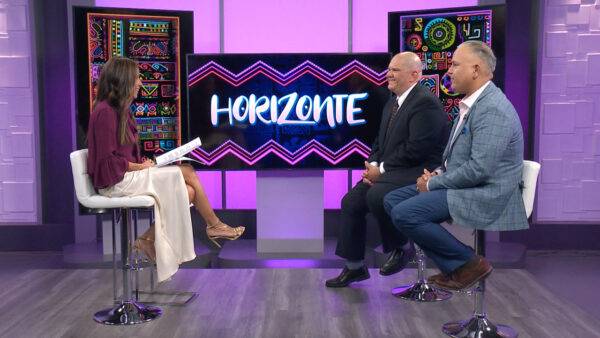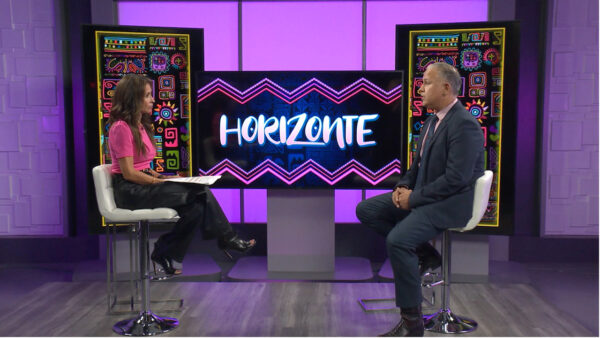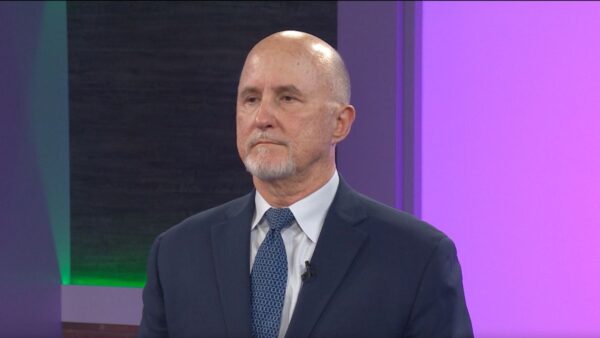The Arizona Hispanic Chamber of Commerce (AZHCC) released its annual DATOS report focused on the state of Arizona’s Hispanic market. According to the data, Hispanics in Arizona are spending about $46 billion dollars annually on goods and services statewide. Lisa Urias, chair for the Arizona Hispanic Chamber of Commerce board of directors and owner of Urias Communications and AZHCC Vice President Monica Villalobos discuss the report.
Jose Cardenas: Thank you for joining us. The Arizona Hispanic Chamber of Commerce released its 18th annual Datos The State of Arizona's Hispanic Market report. According to the data, Arizona hispanics are spending about $46 billion annually statewide, reflecting an annual growth rated of $3 billion a year. Joining me to talk about is Lisa Urias, chair of the Arizona Hispanic Chamber of Commerce about this and owner of Urias communications, and Monica Villalobos, the President for the Arizona Hispanic Chamber of Commerce. Thank you for joining us to talk about datos. It is an annual event for us, not quite 18 years but a good portion. This year's report is different. Both in terms of how you prepared it, and really, the size of the report. Tell us about it.
Monica Villalobos: Several things, it's 50% larger than last year because we have more sources to pull from now. And we have put together and convened a, a committee of subject matter experts, if you will, who really provide the most recent data available and, and that includes the head of the research, many of our corporate partners like srp, cox communications, and cancer treatment centers of America, and because this is their area of specialty, they are able to pull resources from different areas that we would not otherwise have access to. So, we're very fortunate to have those additional sources to pull from.
Jose Cardenas: And I understand that one of the differences in terms of the preparation was more of a focus on education.
Monica Villalobos: There was, really, we were looking at it for the chamber, it's a key topic, and one of the issues that we know is that, that Latino business owners are twice as likely to be college educated and make 50% more income than the total population, and that is significant, a citizenry that we want in Arizona, but when we look at our K-8, that is at more than 50%, Hispanic and, and our educational stand, we're listed 44th in the country so that's this perfect storm, so for us when we look at the numbers, and look at the research, we need to focus more on education, and provide more resources, and expose children to the business principles earlier in their career.
Jose Cardenas: There is actually some, some surprising information that comes with that, but before we go to that, Lisa, let's talk about the presentation of the report at the luncheon, talk about the keynote speaker and some of the things that she had to say.
Lisa Urias: It was a wonderful event. We had a sold-out crowd of 1,000 people there, and the keynote speaker is a univision researcher, a national researcher, and she presented some incredibly interesting data that was part of the datos report about this young Hispanic population that is really equated to the baby boom generation of the 1950s. They are entering into their formation years, 26 years on average, and where the, the general market population, non Hispanic population is about 47. And, and they are, in those key formation years, where they are graduating from college, and entering into the workforce, and buying their first homes and marrying and having children, and that's really the, the key spending years.
Jose Cardenas: And I asked Monica about how datos this year is different than last year, and you've been associated with the chamber for a number of years and on the board and you are now the chair. What's your sense of the progression of datos from when it began 18 years ago, and even more recently to what it is today?
Lisa Urias: Well, really, in the past we focused on census data, and it is important but what's key to what's happening now, with datos and with the leadership of people like Monica is that they are looking much more in-depth at consumer spending, behavior patterns, and what's happening with the market and how do you reach those markets, and it's really important data for, for corporation and is others interested in tapping into that, it's a very, very large demographic, and it's important for those corporations to be able to know what's happening and how they reach them.
Jose Cardenas: We are talking about the President of the chamber and, and who Monica, in many ways is representative of the, of the group that we're talking about here, college educated, worked for major corporations, and now he's heading the chamber, going back to the education, findings, as I understand it, one of them is the percentage of college educated Hispanics who are business owners.
Monica Villalobos: Yes. So, the Latino business owners, are twice as likely to be college educated, but we also know that of this generation that's graduating, only 11% of the bachelor degrees that are conferred go to Latinos, we need to provide resources and increase that number exponentially if we want that citizenry that we know business owners represent.
Jose Cardenas: Go ahead.
Lisa Urias: Excuse me, and education is an important part of, of the Arizona Hispanic chamber now, that we, actually, did our first endorsement, too, of Dr. David Garcia this year, because we think that it is such a key issue. So, we need to make sure that we have got attention and resources going to those children.
Jose Cardenas: And, and what about some of the other findings. We mentioned that there is an increase, but what else is there in the report this year that the corporations need to know and want to know?
Lisa Urias: Well, one of the most important things is that especially these young Millennials, their sensibilities are different than, than people who might be of an older generation. They are retaining Spanish language, for example, and they understand that it's a global market. They understand that they can connect, and the world really is flat, and so they are retaining their language. They like being part of a global community. And, and their sensibilities are quite different in that sense. They love to retain their heritage, so it's a wonderful asset to Arizona and, and it's also, something very new for, for a lot of the Hispanic market who, in the past, may be was, was more focused on just, just English, as their primary language.
Jose Cardenas: So, as I understand it in the report, it says 79% of the Hispanics, and in Arizona, speak some Spanish at home. And but, they are bilingual or at least, they certainly can, can receive messages in English, and the recommendations in the report, as I understand it, is that, that companies communicate in Spanish, in some fashion?
Monica Villalobos: You know, what's really important about language is that it is not one or the other, it's both. There is fluency in both languages, and it's about context, setting and messaging and, and as Lisa mentioned, they did a great presentation and showed us the scientific study where respondents were hooked up with electrodes and shown the exact same commercials in English and in Spanish. And, and there was much more emotional connection with those that were in Spanish, and the only reason is it's the difference between reaching consumers and resonating with consumers. There is some trigger that goes off when, when companies choose to speak to their consumers in Spanish. Not to say that they are not reaching them with English language, or Spanish language, it is got to be a great combination of both.
Jose Cardenas: And Lisa, we talked off the camera about misconceptions about the Hispanic markets. Share those.
Lisa Urias: I think some of them are that it's, it's Spanish only. As Monica just mentioned, and I mean, what's happening is they are bilingual, but the other part of it is that they tend to consume Spanish language mediums more, so, you know, they are, they are watching univision more and listening to the Spanish language radio and online, in English and in Spanish, but their consumption patterns are different. Their sensibilities are different. And so, you know, people who are corporate executives may be sitting across the table from someone who is Hispanic, and never realized that, they think why am I not reaching them doing a typical commercial and don't they just think the way that we do and they have the same consumer pattern behaviors but they really don't. And one of the findings in her book was that they are testing new product lines with younger Hispanics to see how they will -- whether they will be successful within the general market. They are influencing what's happening within the general market, especially from the younger generations.
Jose Cardenas: And isn't one of the misconceptions that this Hispanic population doesn't have that much buying power?
Lisa Urias: Well, that's a big one. I mean, the idea that they don't have spending power or that they are, you know, lower income, I mean, we saw, as well, on average, the, the household, median household income with between 55 and 100,000, and that's a, a high household income for Arizona. And so, their funding, they are making money and doing quite well.
Jose Cardenas: And the out-index, I think is the term, the general population, in every category, explain that to us.
Monica Villalobos: Sure, so, when we look at research, that tells us how much consumers are spending in major categories like, like clothing, food, entertainment and virtually in every major category, Hispanics over-indexed spending in Arizona. So, the myth is that Hispanics don't have any disposable income or that they are sending all their money to Mexico. Those are myths that are dispelled because we know here in the State of Arizona, they are spending 46 billion across every category, and over-indexing across the general population.
Jose Cardenas: And Lisa, is the message getting through, though? You and I talked about, about, about some information that you had about insurance. And, Jose Cardenas: and companies that spend a lot of money on the general market and, and just a pittance on the Hispanic population.
Lisa Urias: It's interesting because it does not seem to be getting through to some degree. I think that, as we were talking about, you know, auto insurance, for example and, and we were looking at, at a study recently of the 2013 spend in Arizona alone, in the Phoenix market. Tens of millions of dollars are spent by auto insurance companies to target general populations, and it was about $43,000 in the Hispanic market within the Spanish language medium. The funny thing about that, is that when you are targeting a 47-year-old, they have insurance. They are already set, so really, you are trying to compete, get them to switch, you know, auto insurance, whereas these younger, Hispanics are looking. They are just buying their homes or just buying their cars and they need insurance, and so they are looking around, and there is really a great opportunity there because no one is really spending in that market very well right now.
Jose Cardenas: So maybe the light bulb will go off in that regard with the consumer spending? One other area I want to touch on is with respect to voting power. The report highlights the fact that, that, that the demographics alone, Hispanics are going to play an important role increasingly role, and yet, that's emphasized by a bunch of groups and, and the impact has yet to be felt.
Monica Villalobos: It's troubling. We know that, that 50,000 Hispanics turn 18 every month in this country. Turn voting age. And, and we know that, that in Arizona, 18, no, 24% of the Democrats are Hispanic, and 8% are Republican, and 18% are independent. It's troubling there is not more outreach, and these are the voters, the future citizens, where, you know, we are on the cusp of becoming a minority-majority marketplace and, and really, I think, that, that politicians need to think twice about reaching out to this particular voter more aggressively, and really, focus on the issues important to the Latinos.
Jose Cardenas: Well, there is a lot to chew on in that datos, as always, and even more so 24 -- this year, thank you both to joining us and talk about it.
Lisa Urias:Chair for Board of Directors and Owner, Arizona Hispanic Chamber of Commerce and Urias Communications; Monica Villalobos:Vice President, Arizona Hispanic Chamber of Commerce;




















